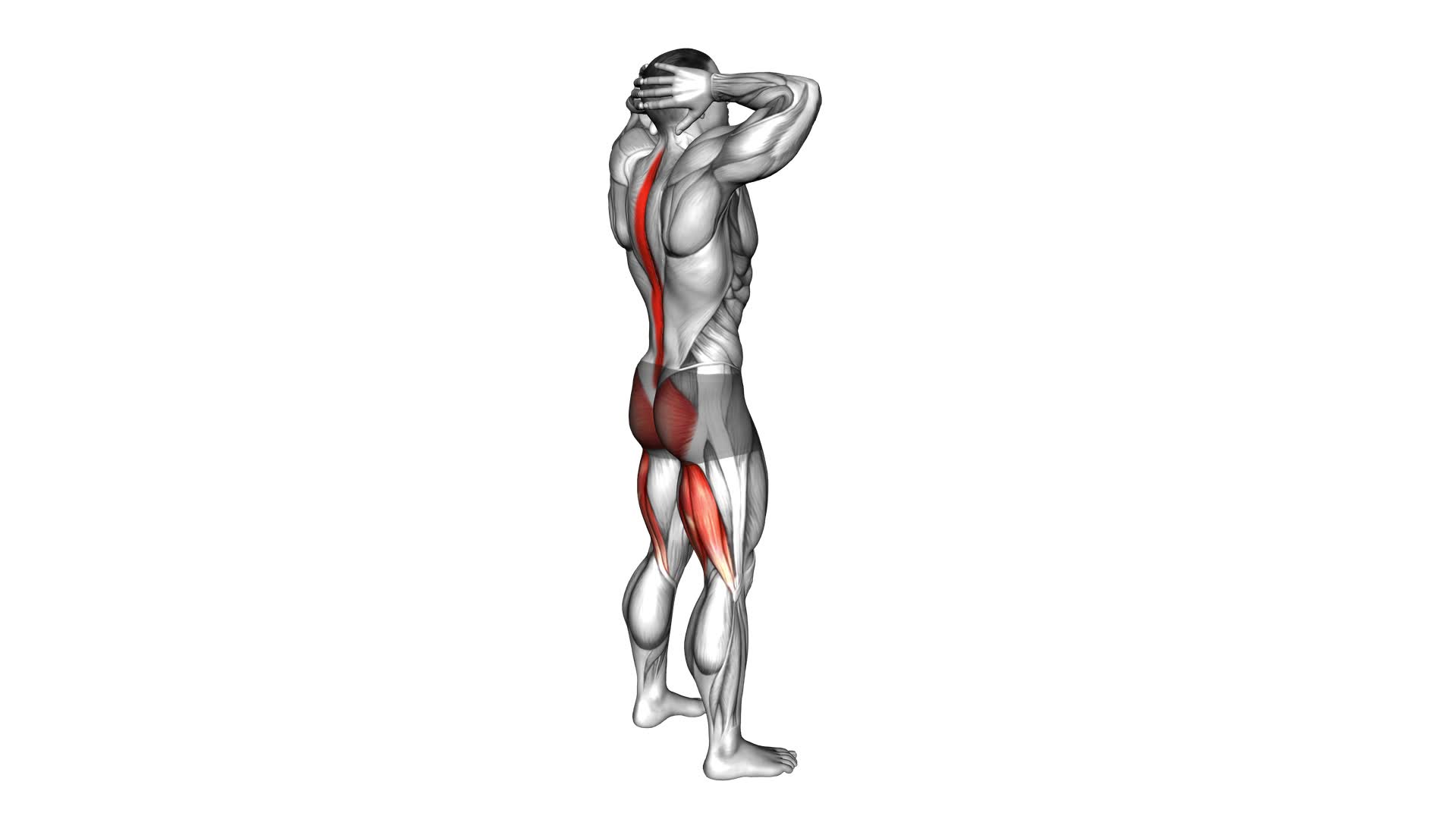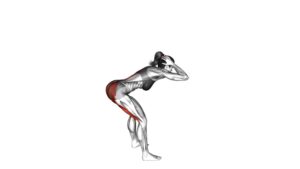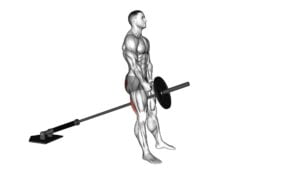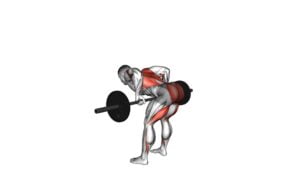Bodyweight Standing Romanian Deadlift (male) – Video Exercise Guide & Tips

Are you looking for an effective lower body exercise that can be done anywhere? Look no further than the bodyweight standing Romanian deadlift.
Watch This Exercise Video
This video exercise guide and tips will show you how to properly perform this movement for maximum results. Whether you're a beginner or an advanced lifter, there are modifications and common mistakes to avoid.
Incorporate the bodyweight standing Romanian deadlift into your workout routine to strengthen your hamstrings, glutes, and lower back.
Key Takeaways
- The Bodyweight Standing Romanian Deadlift incorporates weightlifting without heavy equipment.
- The exercise targets multiple muscle groups including hamstrings, glutes, and lower back.
- Proper technique and form include hinging at the hips, maintaining a straight back, and engaging hamstrings and glutes.
- Beginners should focus on maintaining a stable core, starting with lighter weight to perfect form, and performing slow and controlled movements.
Benefits of the Bodyweight Standing Romanian Deadlift
The bodyweight standing Romanian deadlift offers a variety of benefits for men looking to improve their strength and flexibility. This exercise is a great way to incorporate weightlifting into your routine without the need for heavy equipment. By using your own bodyweight, you can effectively target multiple muscle groups, including your hamstrings, glutes, and lower back.
One of the main benefits of the bodyweight standing Romanian deadlift is its ability to improve your strength. This exercise engages your posterior chain, which includes muscles in your lower back, glutes, and hamstrings. By consistently performing this exercise, you can increase the strength and stability of these muscle groups, leading to improved overall strength.
Another benefit of the bodyweight standing Romanian deadlift is its impact on flexibility. As you perform this exercise, you're required to maintain a straight back and hinge at the hips. This movement helps to stretch and lengthen your hamstrings, promoting increased flexibility over time.
In addition to the benefits mentioned above, the bodyweight standing Romanian deadlift also offers variations that can be incorporated into your workout routine. Some variations include single-leg Romanian deadlifts, staggered stance deadlifts, and kettlebell Romanian deadlifts. These variations add variety to your workouts and allow you to target different muscle groups.
Proper Technique and Form for the Exercise
To perform the bodyweight standing Romanian deadlift with proper technique and form, focus on maintaining a stable and engaged core throughout the movement. This exercise is highly effective for targeting the hamstrings, glutes, and lower back. Here are three key points to keep in mind:
- Hinge at the hips: Start by standing with your feet hip-width apart and your knees slightly bent. Engage your core and maintain a slight arch in your lower back. As you lower your upper body, hinge at the hips and push your buttocks back, keeping your back straight.
- Keep your knees soft: It's important to avoid locking your knees during the movement. Instead, maintain a slight bend in your knees to prevent any unnecessary strain on the joints.
- Control the descent: As you lower your upper body, make sure to control the descent by engaging your hamstrings and glutes. Avoid rounding your back or allowing your shoulders to roll forward. Keep your chest lifted and focus on maintaining a neutral spine throughout the exercise.
Common misconceptions about the bodyweight standing Romanian deadlift include using excessive weight and neglecting proper form. Remember, it's crucial to prioritize quality over quantity. As you become more comfortable with the exercise, you can gradually increase the resistance by incorporating variations such as single-leg Romanian deadlifts or adding weights.
Progressions can also include using resistance bands or performing the exercise on an unstable surface, such as a balance board or foam pad. These variations and progressions can further challenge your stability and strengthen your muscles in different ways.
Tips for Beginners to Master the Movement
When starting out, focus on maintaining a stable and engaged core throughout the bodyweight standing Romanian deadlift exercise. This is crucial to prevent injury and ensure proper form.
One of the most common beginner mistakes is rounding the back during the movement. To avoid this, imagine that you're pushing your hips back as if you're closing a car door with your glutes. This will help you maintain a neutral spine position.
Another important tip for beginners is to start with a lighter weight or no weight at all and gradually progress as you become more comfortable with the movement. This will allow you to focus on perfecting your form and technique before adding more load.
Additionally, it's important to keep your feet shoulder-width apart and distribute your weight evenly throughout your feet. This will provide a stable base of support and improve your balance during the exercise.
Remember to keep your movements slow and controlled, and always listen to your body. As you gain strength and confidence, you can gradually increase the intensity by adding more weight or performing the exercise on an unstable surface.
Modifications for Advanced Lifters
To further challenge yourself as an advanced lifter, consider incorporating these modifications into your bodyweight standing Romanian deadlift routine:
- Progressive Overload: As an advanced lifter, you should focus on gradually increasing the intensity of your workouts. You can achieve this by adding weight to your bodyweight standing Romanian deadlifts. Start by using a weighted vest or holding dumbbells or kettlebells in your hands. This will help you continue making strength gains and prevent plateauing.
- Single-Leg Variation: Take your bodyweight deadlifts to the next level by performing them on one leg. This advanced variation not only increases the challenge but also improves balance and stability. Stand on one leg and hinge at the hips while keeping the other leg extended behind you. Make sure to maintain proper form and control throughout the movement.
- Unstable Surface: Another way to advance your bodyweight standing Romanian deadlifts is by performing them on an unstable surface. This could be a balance board, BOSU ball, or foam pad. The instability forces your muscles to work harder to maintain balance, thus further engaging your core and lower body.
By incorporating these progressive overload and advanced variations into your routine, you can continue challenging your muscles and making progress.
Now, let's move on to the next section to learn about common mistakes to avoid.
Common Mistakes to Avoid
To avoid common mistakes and ensure proper form, focus on the following key points when performing the bodyweight standing Romanian deadlift.
- The first common mistake to avoid is rounding your back. It's essential to maintain a neutral spine throughout the movement to prevent any unnecessary strain on your lower back. Engage your core and keep your shoulders back and down to maintain proper posture.
- Another mistake to watch out for is using your arms to pull yourself up. Remember, this exercise primarily targets your hamstrings and glutes, so it's crucial to rely on the strength of your lower body rather than using your arms for assistance. Additionally, make sure to keep a slight bend in your knees to engage your leg muscles properly.
- Lastly, avoid rushing through the movement. Take your time and focus on the mind-muscle connection, feeling the stretch in your hamstrings as you lower your torso.
Incorporating the Bodyweight Standing Romanian Deadlift Into Your Workout Routine
To incorporate the bodyweight standing Romanian deadlift into your workout routine, focus on gradually increasing the number of repetitions and sets performed, while also challenging yourself with additional weight or variations of the exercise. This won't only help you increase flexibility, but also target your glutes and hamstrings for a more effective workout.
Here are three tips to help you incorporate this exercise into your routine:
- Start with bodyweight: Begin by mastering the proper form and technique of the bodyweight standing Romanian deadlift. This will ensure that you're performing the exercise correctly and safely. Once you feel comfortable with the movement, you can gradually add weight to increase the intensity.
- Increase repetitions and sets: As you become more proficient in the exercise, aim to gradually increase the number of repetitions and sets you perform. This will help to improve muscular endurance and promote muscle growth in your glutes and hamstrings.
- Try variations: To keep your workouts challenging and prevent plateaus, consider incorporating variations of the bodyweight standing Romanian deadlift into your routine. This can include using dumbbells or kettlebells, performing single-leg variations, or adding in a balance component by standing on an unstable surface.
Frequently Asked Questions
How Many Sets and Reps Should I Do for the Bodyweight Standing Romanian Deadlift?
To determine the number of sets and reps for the bodyweight standing Romanian deadlift, consider your workout frequency and goals.
For beginners, start with 2-3 sets of 8-12 reps to build strength and proper form.
As you progress, increase the intensity by adding more sets or using variations like single-leg or weighted deadlifts.
Remember to listen to your body and adjust accordingly.
Can I Use Weights or Resistance Bands to Make the Exercise More Challenging?
Yes, you can definitely use weights or resistance bands to make the bodyweight standing Romanian deadlift more challenging. Adding weights or resistance bands increases the resistance and intensity of the exercise, targeting your muscles even more effectively.
This can lead to greater strength gains and muscle development. However, it's important to start with lighter weights or resistance bands and gradually increase the difficulty to avoid injury and ensure proper form.
Is This Exercise Suitable for People With Lower Back Pain or Injuries?
If you have lower back pain or injuries, it's important to approach exercises with caution. Before attempting the Bodyweight Standing Romanian Deadlift, consult with a healthcare professional or a qualified trainer. They can provide exercise modifications that are suitable for your condition.
It's crucial to prioritize your safety and avoid aggravating your lower back. Always listen to your body and stop if you experience any pain or discomfort during the exercise.
How Often Should I Include the Bodyweight Standing Romanian Deadlift in My Workout Routine?
To improve balance in the bodyweight standing Romanian deadlift, it's important to include this exercise regularly in your workout routine. Incorporating this exercise into your routine has many benefits, such as strengthening your glutes, hamstrings, and lower back.
It also helps to increase your stability and overall body control. Aim to perform this exercise at least 2-3 times a week to see improvements in your balance and strength.
Are There Any Alternatives to the Bodyweight Standing Romanian Deadlift That Target Similar Muscles?
If you're looking for alternatives to the bodyweight standing Romanian deadlift that target similar muscles, there are a few variations of Romanian deadlifts you can try.
One option is the traditional barbell Romanian deadlift, which involves using a barbell with added weights.
Another option is the dumbbell Romanian deadlift, which uses dumbbells instead of a barbell.
Both of these variations work the same muscle groups as the bodyweight standing Romanian deadlift and can be great alternatives in your workout routine.
Conclusion
Incorporating the bodyweight standing Romanian deadlift into your workout routine can provide numerous benefits. This includes improved hamstring and glute strength, increased stability, and enhanced overall body control. By focusing on proper technique and form, beginners can efficiently master this movement. Advanced lifters can make modifications to continue challenging themselves. Avoid common mistakes and enjoy the benefits of this exercise for a well-rounded fitness routine.

Author
Years ago, the spark of my life’s passion ignited in my mind the moment I stepped into the local gym for the first time. The inaugural bead of perspiration, the initial endeavor, the very first surge of endorphins, and a sense of pride that washed over me post-workout marked the beginning of my deep-seated interest in strength sports, fitness, and sports nutrition. This very curiosity blossomed rapidly into a profound fascination, propelling me to earn a Master’s degree in Physical Education from the Academy of Physical Education in Krakow, followed by a Sports Manager diploma from the Jagiellonian University. My journey of growth led me to gain more specialized qualifications, such as being a certified personal trainer with a focus on sports dietetics, a lifeguard, and an instructor for wellness and corrective gymnastics. Theoretical knowledge paired seamlessly with practical experience, reinforcing my belief that the transformation of individuals under my guidance was also a reflection of my personal growth. This belief holds true even today. Each day, I strive to push the boundaries and explore new realms. These realms gently elevate me to greater heights. The unique combination of passion for my field and the continuous quest for growth fuels my drive to break new ground.







